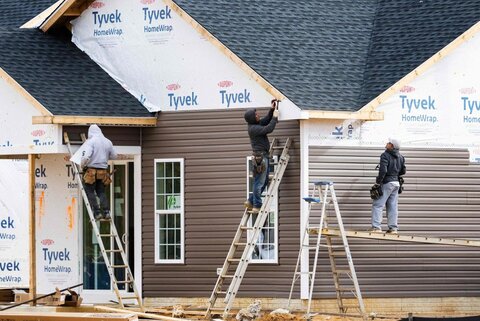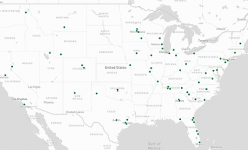
Norbert Michel and Jerome Famularo
In the aftermath of the COVID-19 pandemic, the United States experienced a much higher rate of inflation than at any time during the prior few decades. Like the prices of many goods and services, the cost of housing rose rapidly, with the median home price increasing almost $100,000. (Figure 1.) Unsurprisingly, many potential homebuyers were—and still are—shocked and upset.
As they have in years past, many politicians have latched on to the anger surrounding the recent housing market turmoil. During the presidential debate, Vice President Kamala Harris said. “Here’s the thing: we know that we have a shortage of homes and housing. And the cost of housing is too expensive for far too many people.” Prior to the election, Donald Trump outlined his own solutions, and now federal officials want to implement a host of policies, ranging from subsidies to selling federal land.
But is the United States really facing a housing crisis? Or a shortage of homes? And should Americans really expect recent federal policy proposals to make housing more affordable?
This Cato at Liberty post is the third in a series that examines these questions. (Previous posts are here and here.) While the series presents evidence that the United States is not facing a true housing crisis or shortage, nothing in the series suggests that local officials should refrain from relaxing zoning restrictions and other regulations.
Elected officials should reduce rules and regulations to make it easier and less costly for people to live. Additionally, federal officials should end the many demand-side policies that place upward pressure on prices across the nation.
Just as important, nothing in the series ignores that many Americans have taken an economic beating these past few years—real wages have fallen, and prices have not reverted to pre-COVID levels. It is no surprise that so many people have been calling for increased government intervention.
As previously, though, if federal officials answer those calls, it will likely increase Americans’ economic burden. Evidence shows that over the long term, people have overcome the many federal roadblocks that increase the nominal cost of housing, but affordability would be much improved in the absence of those policies.
Fortunately, federal officials have an excellent opportunity to make it easier for Americans to afford housing because the lessons learned from the post-COVID-19 inflationary episode are directly applicable to the housing market. In both cases, federal policies that distort both demand and supply result in harmful outcomes. The housing market is just a microcosm of what can go wrong—and how difficult it can be to fix—when the federal government interferes with markets.
This post focuses on affordability and whether consumer preferences might have been driving prices higher over the past few decades. While the previous post considered several important adjustments to nominal (and real) home prices, several other changes in consumer preferences and quality suggest that people have been choosing to pay for more with respect to housing.
For instance, in the 1980s, most newly constructed homes had three bedrooms. Now, most have at least four bedrooms, even though household sizes have been decreasing. (Figure 2.) Similarly, in the 1980s, many homes were still built without air conditioning or garages, but those numbers have trended downward. Now, almost all new homes are built with both air conditioning and a garage (Figure 3). These kinds of changes suggest that consumer preferences—and thus, demand—drive prices in the housing market.
Renters Also Paying for More Housing
Interestingly, some policymakers concede that changing consumer preferences might explain Americans’ increased expenditures on housing but still claim that housing has become unaffordable. The 2024 Economic Report of the President, for instance, acknowledges that “increased spending on housing could be a rational consumption choice.” It then argues, without much evidence, that this higher spending is not by choice.
To support its claim, the president’s report uses a US Department of Housing and Urban Development benchmark (developed in 1969 and last updated in 1980), which defines a family as “rent burdened” if it spends more than 30 percent of its income on housing (rent/mortgage, utilities, and other housing needs). Using this metric, the report shows that the “share of households burdened by housing expenses has risen steadily over the last 60 years” and that “nearly 45 percent of renters are rent-burdened.” The report also shows that, since 1960, the percentage of renter households spending more than 40 percent and 50 percent of their income on rent, respectively, has steadily risen.
These shares did rise, but they merely confirm that people have been spending more on housing. So, despite acknowledging consumer preference changes (such as choosing to spend a greater portion of their income on larger homes or those with more amenities) could have been driving the trend, the president’s report does nothing to account for those changes.
The report also fails to account for whether renters are now able to spend more of their budgets on housing for other economic reasons, such as higher real earnings or lower cost of non-housing items.
In fact, the president’s report contains evidence—though it ignores it—that households have not been losing the ability to spend more during the past few decades. Specifically, the report presents a graph (figure 4–3 in the report) of the minimum monthly hours of work needed to pay for the median monthly rent. The graph shows that the hours needed essentially remained the same in 2002 and 2012 (for the median wage earner, the minimum wage earner, and someone at the federal poverty level, respectively).
The hours needed only increased in 2022, after the COVID-19 pandemic—a problem that occurred for nearly all goods and services. For the median worker, the number of hours increased to “more than 70 hours in 2022,” up from 55 in 2002.
Figure 4 confirms this finding. It shows that work hours needed to afford rent were very stable from 2007 to 2019. Additionally, both rent and food as a percentage of income varied little until the pandemic. (Figure 5.) That is, the recent spike is anomalous—it has certainly been harmful for many people, but it was not indicative of a long-term trend. To the extent that nominal incomes continue to rise, the real effects from this spike will continue to dissipate.
The president’s report also ignores that the share of workers in poverty and the share of workers earning at or below the minimum wage were both smaller in 2022 versus 2012. According to the BLS, the 2012 share in poverty was 15.9 percent, but it declined to 12.6 percent in 2022, while the share of Americans making at or below the minimum wage declined from 1.1 percent (3.55 million workers out of 314,725,000 Americans) in 2012 to 0.3 percent (1.023 million workers out of 333,568,000 Americans) in 2022.
Various other metrics also contradict the idea that households have steadily become more economically burdened because of housing costs during the past few decades. For example, the square footage that the average householder can afford has increased slightly, with little variation, from 1975 to 2024. (Figure 6.) (The metric displayed in Figure 6 is merely an alternative way to view the data presented in the second post of this series.)
Comparing Costs
Separately, outside of housing costs, most consumer goods and services have become more affordable over time, suggesting that Americans can afford to spend more on housing than they did in the 1960s and 1970s.
The second largest expenditure for most Americans (after housing but before necessities such as food) is vehicle costs, and those have declined. For example, in 1992, a Toyota Camry cost 55 percent of median household income. But by 2023, a Camry cost just 34 percent of the median household income. And, as with other vehicles, the 2023 Camry is much different than it was a few decades ago—it is more powerful (203 vs. 130 HP in 1992 model) and more efficient (it averages 32 MPG vs. 21 MPG), and it has more standard convenience and safety features.
These findings are consistent with the work that our Cato colleagues have done at Human Progress. They show, for example, that “basic food items in America have become almost eight times cheaper relative to unskilled labor over the last 100 years.” Together, this kind of evidence supports the idea that consumer preferences do explain at least some of Americans’ increased expenditures on housing.
Separately, it is possible to compare the portion of annual median household income needed to buy the average-priced home to the portion of income needed to pay 12 years of average rent. Figure 7 plots both of these series. Although both series spiked during the COVID-19 pandemic, the rent series was otherwise stable for the full period, and the only other spike in the home purchase data was prior to the 2008 crisis. (Based on the standard deviation, a common measure of variation, the increases in 2021, 2022, and 2023 were anomalous.)
To date, this series has presented a great deal of data that goes well beyond just the nominal cost of housing. That’s partly because it is so difficult to tell when something has become “less affordable” over time. But after analyzing the affordability question from many angles, the United States is not suffering from a long-term housing crisis.
Though the recent spike in prices has surely harmed many Americans, that spike does not justify a massive federal effort to “fix” the housing market. Indeed, long-term housing affordability would be much improved in the absence of the many federal policies that distort the market.
Nonetheless, the housing shortage story remains part of the conventional wisdom. The next post in this series will examine the data behind that supposed shortage.






















